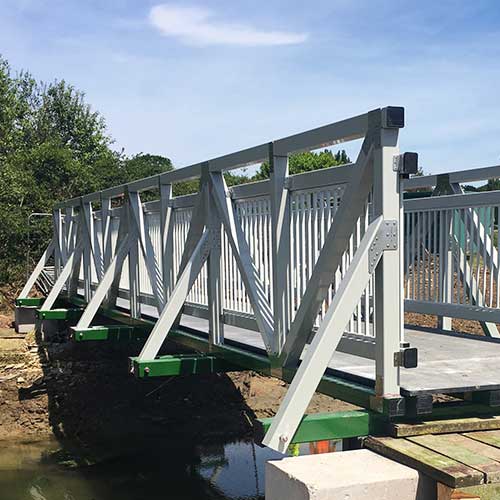
Pedestrian bridges are structures that provide safe and convenient access for pedestrians, cyclists, equestrians, and other non-motorized users across various obstacles, such as roads, railways, rivers, or valleys. Pedestrian bridges can also enhance the aesthetic and environmental value of the surrounding landscape, as well as promote health and well-being of the users.
One of the materials that can be used for pedestrian bridge construction is glass-fiber reinforced plastic (GFRP), also known as fiberglass or glass-reinforced polymer (GRP). GFRP is a composite material that consists of a polymer matrix (such as polyester, epoxy, or vinyl ester) that is reinforced with glass fibers. GFRP has several advantages over traditional materials, such as steel, concrete, or wood, for pedestrian bridge applications. Some of these advantages are:
High strength-to-weight ratio: GFRP is four times lighter than steel and 30% lighter than aluminum, but has comparable or higher tensile and flexural strength. This means that GFRP bridges can support heavy loads with less material and weight, which reduces the foundation and transportation costs, as well as the environmental impact.
Corrosion and chemical resistance: GFRP is immune to rust, rot, decay, and insect attack, and can withstand exposure to harsh weather conditions, salt water, acids, alkalis, and other corrosive agents. This means that GFRP bridges require minimal maintenance and have a long service life, which saves time and money in the long run.
Design flexibility: GFRP can be molded into various shapes and sizes, and can be customized to meet specific requirements of the bridge design. GFRP can also be colored or textured to match the aesthetic preferences of the bridge owner or the surrounding environment.
Easy installation: GFRP can be fabricated into prefabricated modules or panels that can be easily assembled on site with simple tools and techniques. GFRP can also be attached to existing structures without affecting their integrity, which makes it suitable for retrofitting or upgrading old bridges.
Sustainability: GFRP is a recyclable material that can be reused or reprocessed into new products at the end of its life cycle. GFRP also reduces the carbon footprint of the bridge construction by using less energy and resources than conventional materials.
There are different types of GFRP profiles that can be used for pedestrian bridge construction, depending on the design and function of the bridge. Some of the common GFRP profiles are:
Decking: GFRP decking is the surface layer of the bridge that provides support and traction for the users. GFRP decking can be made of solid or hollow planks, gratings, or panels that are connected by bolts or clips. GFRP decking can have various surface finishes, such as smooth, rough, grooved, or anti-slip. GFRP decking can also incorporate features such as drainage holes, lighting fixtures, or heating elements.
Beams: GFRP beams are the structural elements that span across the bridge supports and carry the load of the decking and the users. GFRP beams can be made of solid or hollow sections that have different cross-sectional shapes, such as I-beams, T-beams, C-beams, box beams, or tubes. GFRP beams can also have different orientations, such as parallel or perpendicular to the bridge axis.
Trusses: GFRP trusses are assemblies of beams that form triangular units that distribute the load evenly across the bridge span. GFRP trusses can have different configurations, such as Pratt trusses, Warren trusses, Howe trusses, or K-trusses. GFRP trusses can also have different depths and angles to optimize the strength and stiffness of the bridge.
Arches: GFRP arches are curved beams that support the bridge deck from below or above. GFRP arches can have different shapes, such as circular arches, parabolic arches, elliptical arches, or catenary arches. GFRP arches can also have different spans and heights to create different visual effects and clearance levels for the bridge.
Cables: GFRP cables are flexible strands that suspend the bridge deck from above or below. GFRP cables can have different diameters and lengths to adjust the tension and sag of the bridge. GFRP cables can also have different arrangements, such as simple cables, cable-stayed cables, or suspension cables.
These are some examples of how GFRP profiles can be used for pedestrian bridge construction. However, there are many more possibilities and combinations that can be explored with this versatile material. By using GFRP profiles for pedestrian bridges, engineers and architects can create innovative and sustainable solutions that meet the needs and expectations of the bridge owners and users.
 +86 15303735673
+86 15303735673 Jessica@frpzs.com
Jessica@frpzs.com
 Technical Data
Technical Data











